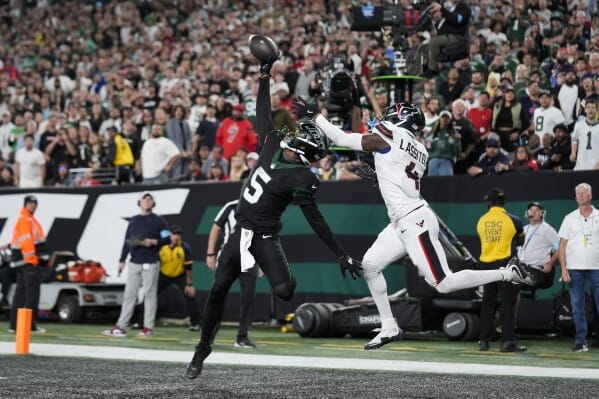
Zay Flowers Leads a Group of Undersized Potential 1st Rounders—Rookie WRs Tier 3
3/28/2023
In Part 1 of my rookie WR profiles, I covered my top three WR prospects and provided a quick class overview. In that overview, I was skeptical of the depth of the 2023 WR class. But while the class has fewer high-end profiles than in the last three years, there are some interesting names and several likely to be drafted highly in the NFL Draft.
Let's dive in.
Tier 3 - Bet on Draft Capital
Zay Flowers
At a Glance
Flowers is a productive four-year player who looks likely to be selected in the 1st round of the NFL Draft. Although undersized, he played primarily on the outside in college and projects to be a downfield contributor in the NFL.
Positive Indicators
Flowers was extremely productive in his final three seasons at Boston College, with per-game averages of 5.1 receptions for 77.6 yards and 0.74 TDs from 2020-22. Flowers' production was even more impressive in the context of the Boston College offense. As a true sophomore, he accounted for 29% of Boston College's receiving yards and 39% of their receiving TDs. This was good for a 34% dominator rating (which averages yardage share and TD share).
Critically, Flowers' 2020 season was well above the 30% dominator rating threshold used to determine a breakout season. Flowers broke out at 20.3 years old, which helps ease concerns about him being an older prospect.
Flowers' career production also helps lessen concerns that he did not declare early for the NFL Draft. He was a highly productive four-year player with a 29% career yardage share. Generally, three-year wide receivers tend to be the highest ceiling prospects, but plenty of four-plus-year players have gone on to have NFL success. Most of them were highly productive in college – like Flowers.
As I'll get to, the concern with Flowers is if his production at a middling program is strong enough to indicate NFL success. But although there are some holes to poke in his production profile, the way Flowers won in college should readily translate to the NFL game.
Flowers never produced more than 10% of his yards on screens. He is a smaller receiver but not a gadget player. Instead, Flowers' strength is down the field. He produced 50% of his yards on targets 20+ yards downfield. That's just below DK Metcalf (52%), Darius Slayton (52%), and Christian Watson (51%). It's also above NFL deep threats like Courtland Sutton (47%), Terry McLaurin (45%), and Gabriel Davis (44%).
Flowers will not be bullying NFL cornerbacks; he posted just a 38% contested catch rate on deep targets. But that won't matter if he's left his coverage defender in the dust. Just 25% of Flowers' deep targets were contested. This is a rate in line with Marquise Brown (27%). As I'll get to, size is a concern for Flowers. But if Flowers can separate deep with high-end route running, his size won't be a huge issue.
Flowers also has 345 career rushing yards and two career rushing TDs, with a career YPC of 6.1. Most of his rushing production came in his freshman year while he was still figuring out the WR position in college. That versatility could provide some bonus production in his rookie season in the NFL. It also hints at the potential for underneath target ability if he doesn't quite translate as a downfield threat.
Red Flags
Flowers was the engine of his college offense, but that offense wasn't very good. In Flowers' three highly productive seasons, Boston College ranked 64th of 111 qualifying schools in success rate against Power 5 opponents; they were slightly better in EPA per play, ranking 53rd.
And Flowers' receiving efficiency wasn't ideal either. With a career YPRR of 2.16, he hardly embarrassed himself. Still, he peaked at 2.27 YPRR in 2021 before falling off slightly as a senior to 2.22.
By contrast, Flowers isn't even in the same ballpark as Jaxon Smith-Njigba (3.32 career YPRR) and was significantly less efficient than Quentin Johnston (2.71) and Jordan Addison (2.64) as well.
One of the potential issues with high market share producers from non-elite programs is that it's possible they were the best of bad options. Flowers wasn't inefficient, but his YPRR doesn't dispel the idea that he was simply the best option in an underwhelming offense. We've seen players like N'Keal Harry, Andy Isabella, and Jalen Tolbert get drafted highly after productive careers in mediocre offenses. Those receivers also lacked strong YPRR efficiency. This was also the case for receivers like Brandon Aiyuk and Christian Kirk, so it's not necessarily the end of the world.
But Flowers' weight also creates doubt about his ability to translate his production to the NFL. He weighed in at the Combine at 5-foot-9, 182. Adam Levitan has established minimum thresholds based on previous top-10 fantasy WRs. The thresholds for height and weight are 5-foot-10, 190.
The fact that Flowers is a little more compact than usual does not mean we should write him off. But Flowers is about to face a massive upgrade in level of competition. While leveling up his game, he'll also have to overcome smaller-than-ideal size. And he'll be doing so without elite athleticism, per Kent Lee Platt's RAS scores.

And while Flowers was very productive at Boston College, he wasn't insanely dominant like we've seen from several successful upperclassmen prospects. For example, Greg Jennings had a 32% career yardage share; Roddy White and Courtland Sutton were at 33%; Jordan Matthews was at 43%; and Demaryius Thomas had a ridiculous 46% career yardage share. Flowers' level of production gives him solid odds of hitting in the NFL, but compared to the WRs above, he was not overwhelmingly productive.
Statistical Comps
- Corey Coleman
- Will Fuller
- Kendall Wright
- Michael Floyd
Coleman comes up as Flowers' closest comp. Coleman redshirted and didn't do much in his first college season. He was productive in his final two seasons but not off the charts – similar to Flowers' second and third seasons. The nice thing is that Flowers started producing earlier, in his true sophomore season. And Flowers was outstanding as a senior, delivering a 36% yardage share and a 57% TD share; Coleman never had a season like that. Still, Coleman was a major bust at the No. 15 overall pick and is a reminder of the low floor that we sometimes see with four-year players.
With late-1st-round draft capital, Fuller pops as a very close comp. Fuller was a highly productive three-year player who matched Flowers' 47% final-season dominator rating. As an early declare, he looked like a slightly better prospect. But despite weighing just 186 at the Combine, Fuller still managed to be a productive NFL deep threat.
Wright is generally remembered as a bust, but that's a bit unfair. He delivered 150 PPR points as a rookie and hit 13.4 points per game in his second season. He was more of an underneath option than Flowers is likely to be but was similarly productive in college. His peak season wasn't as impressive as Flowers', but unlike Flowers, he broke out as a true freshman.
Floyd was much heavier than Flowers but was another productive four-year player who was a downfield threat in the NFL. He isn't an inspiring name, but he put up 1,041 yards in his second season. Like Wright, he's remembered as more of a clear-cut disappointment than he actually was.
Best Ball Outlook
Flowers' ceiling projection is pretty straightforward. If he's a skilled enough route runner to get open deep, as he did at Boston College, he'll have a very valuable NFL role. On the other hand, if the increased level of competition keeps him fairly well covered, it's not clear that he has another path to big-time fantasy value. In other words, as an undersized receiver with good but non-elite speed and explosion, he could have trouble standing out if he can't consistently separate deep.
Flowers is expected to go higher in the NFL Draft, likely landing in the 1st round. With that level of team investment, he has a path to plenty of targets as a rookie. And even if he's not succeeding deep, he could see schemed touches, which his rushing production points to as a viable option. Even in outcomes where he doesn't develop into a high-end receiver, he could provide some decent production in the mold of Floyd or Wright.
But while Flowers is expected to have high draft capital, that is somewhat priced in on Underdog, where he is going in the early 9th round. If he lands in a potent offense, his price can definitely rise from here. But as an undersized four-year player, he needs to hit the landing spot nuts to be worth more than about a 7th-round pick. He's much cheaper on FFPC, where he's going at the 10/11 turn. At that price, he feels more palatable, given his good but not great profile.


